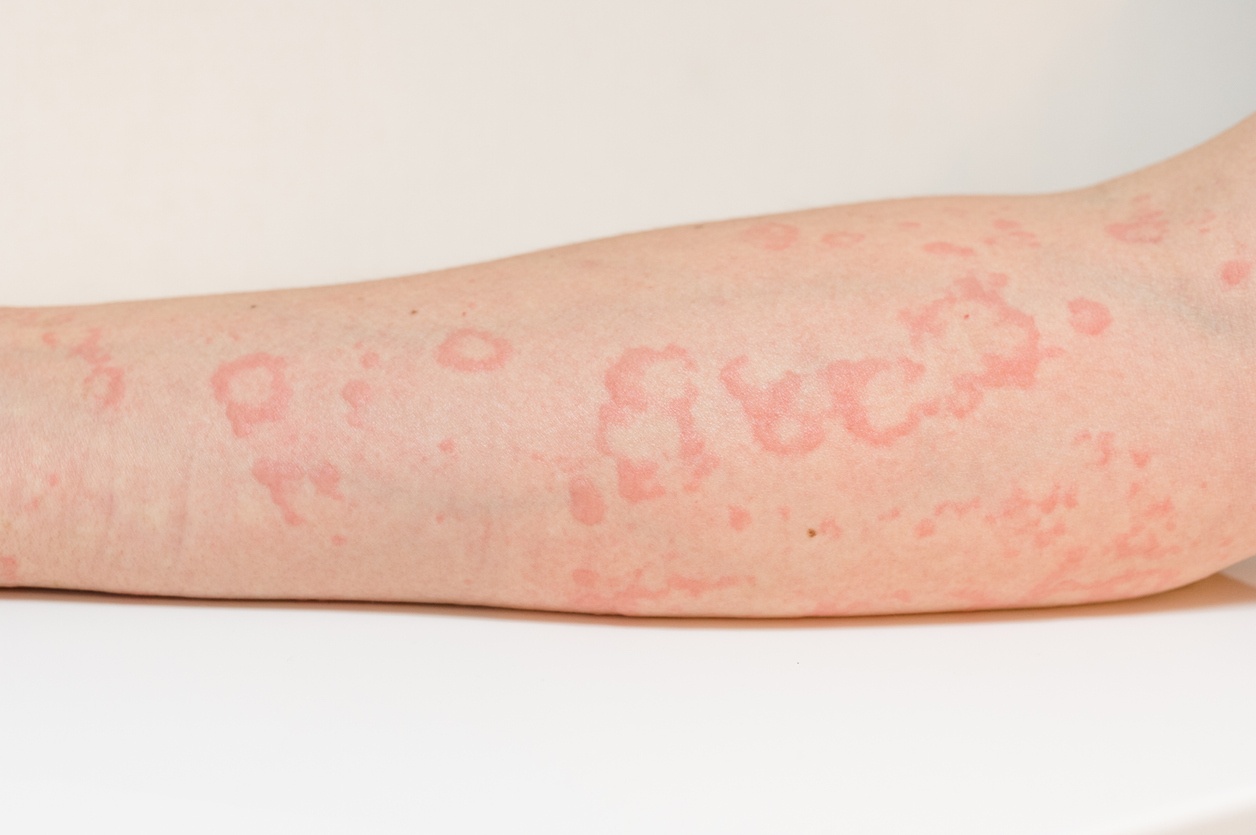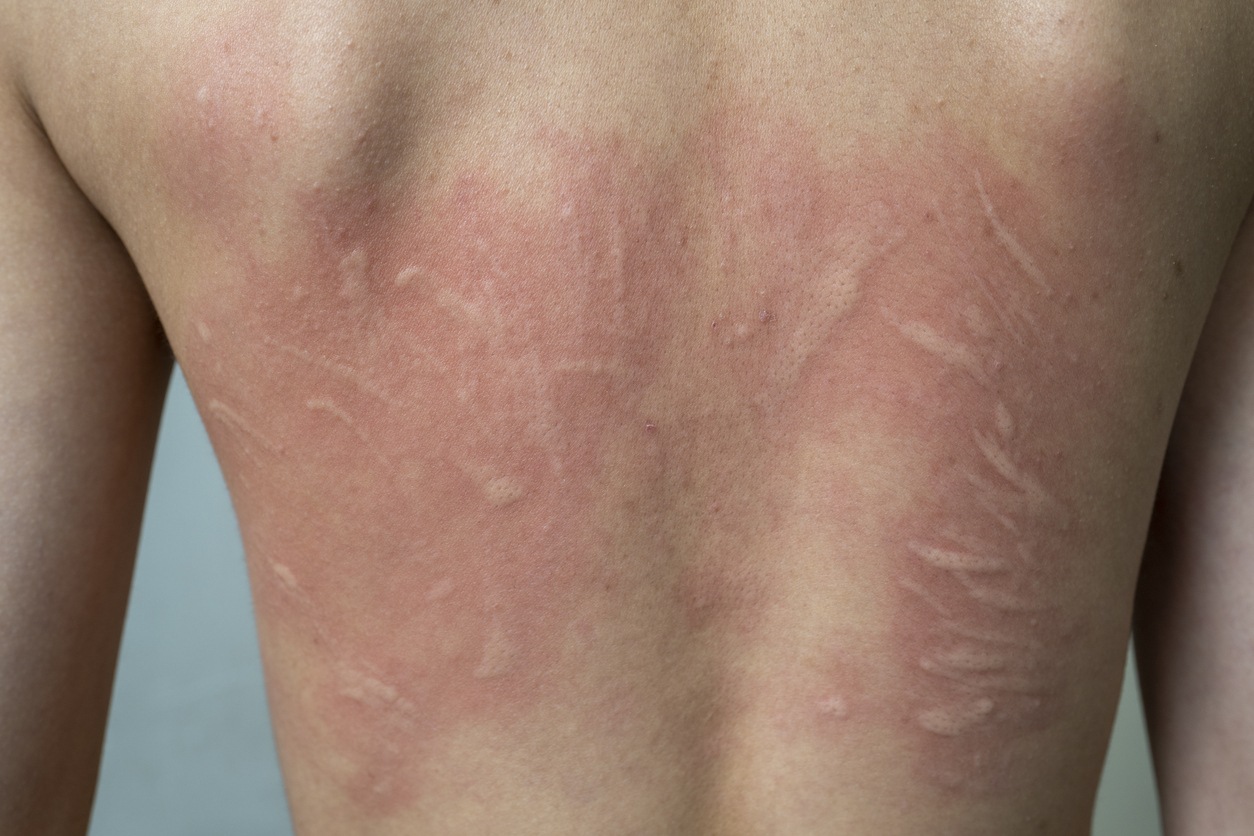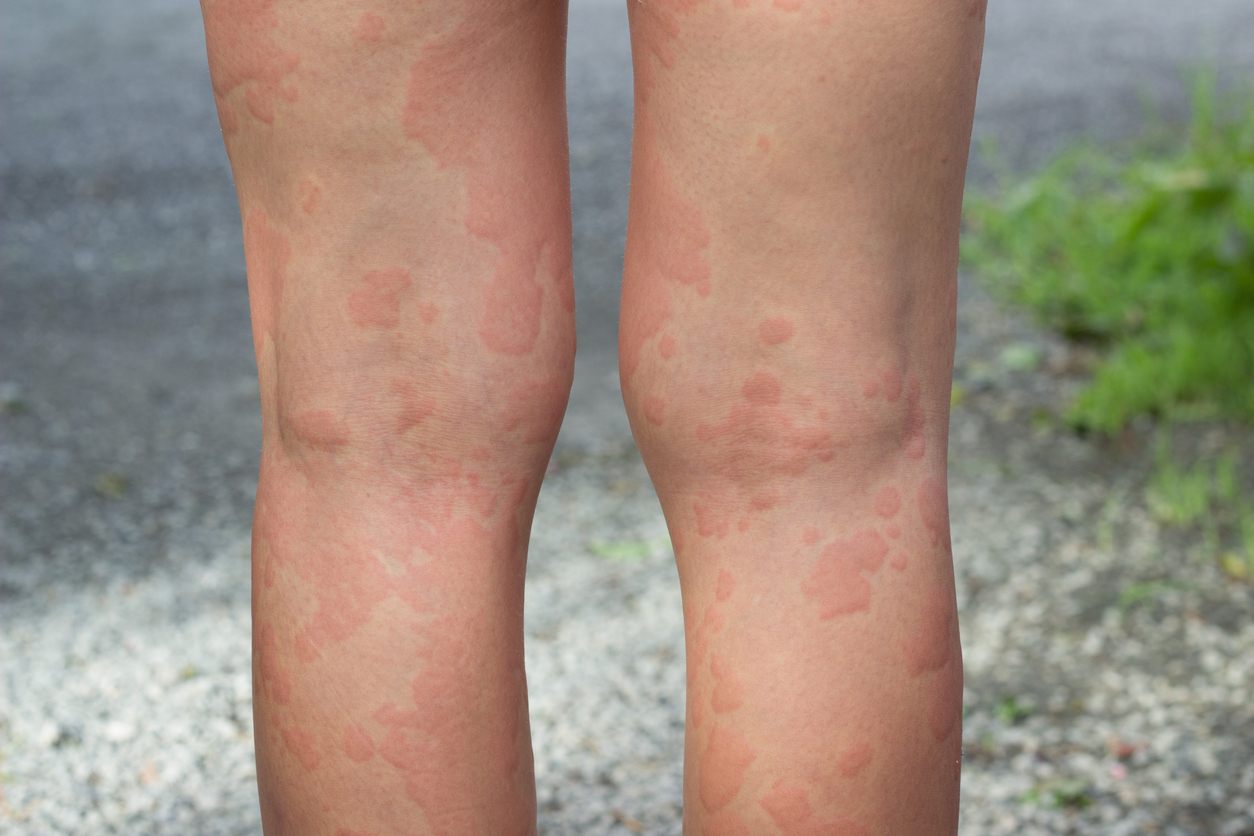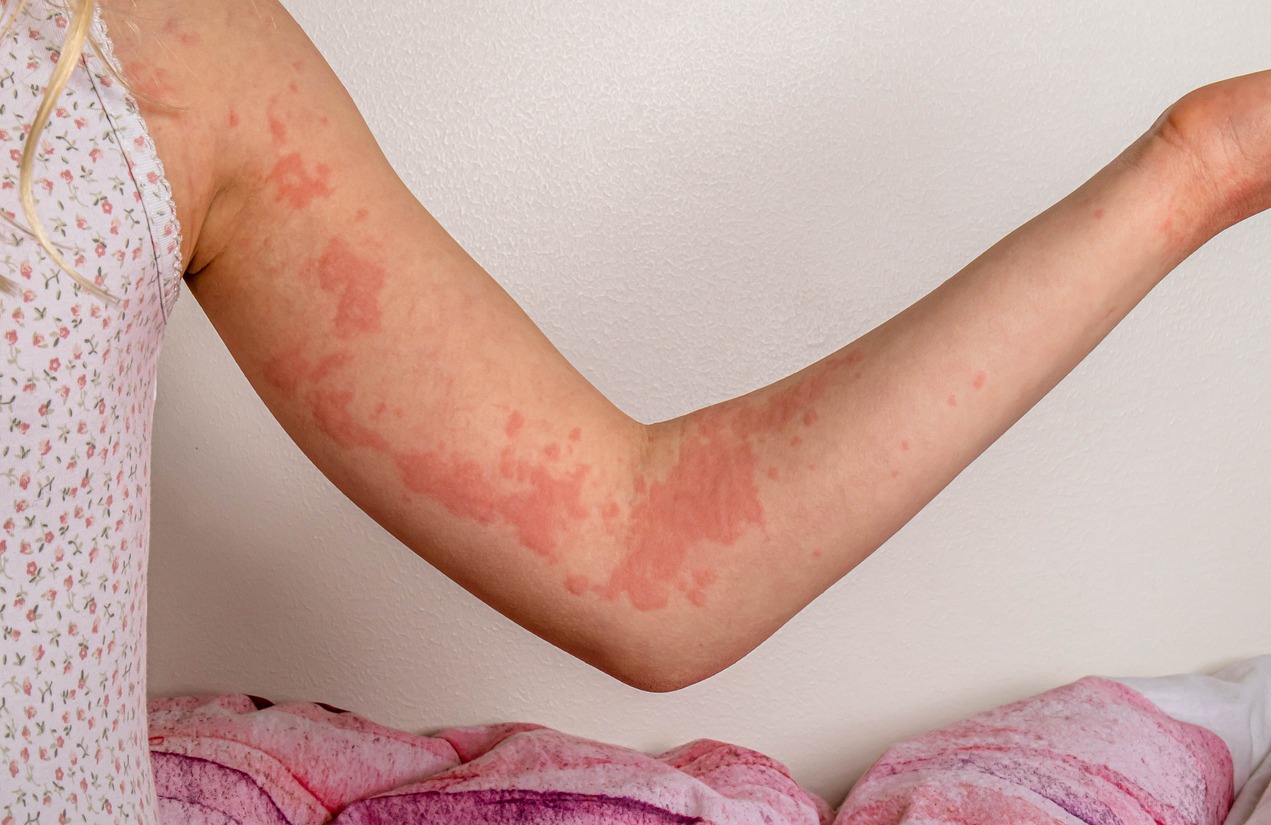What are Hives (Urticaria)?
Hives are raised red or skin-colored welts, rashes, spots, or map-like patches that typically flare up suddenly and have a habit of changing shape or moving from one area of the body to another. They are an unusual type of skin rash in that they can look very different from one person to the next. The welts can be tiny or large, incredibly itchy and surrounded by a wheal (also called weals). These wheals can form rings or coalesce to form a giant patch.
.64b9fe516a110.jpg)
In 10% of people, there may also be swelling or edema which may affect the eyelids, lips, hands or elsewhere. This is called angioedema and, in most people, this accompanying condition is very short-lasting and not serious. However, if the swelling affects a person's throat and hinders their breathing or makes their voice hoarse, call 911 or go to the emergency room immediately.
The medical term for hives is urticaria which comes from the Latin words urtica (which means nettle) and urere (which means to burn).
Symptoms May Vary from Person To Person
It is not uncommon for hives to look different from one person to the next. In fact, even in the same person, the rash may vary from one day to another, or with different episodes.
Even though the welts are raised, their surface is smooth (unlike dermatitis which tends to have a rough surface). In some people, the welts may be bright red, whereas in others they may be paler and skin-colored. Some hives take on a circular appearance with a pale center and a distinctive red halo.

Other symptoms may include a burning or stinging sensation, and when pressed, the center of a red hive usually turns white - this is known as "blanching". Hives can move around the skin, and may last an hour on one part of your body only to disappear and then come back again to a different area.
Causes Of Hives
Although most people assume hives are due to an allergy, more than 75% of hives in adults are NOT allergy-related.
Of those that are due to an allergy, the most common causes are:
- Blood transfusions
- Foods such as berries, chocolate, eggs, fish, nuts, shellfish, soy, or wheat
- Food additives, for example tartrazine or MSG
- Insect stings and bites, or jelly fish stings
- Latex
- Medications (such as antibiotics, aspirin, and ibuprofen)
- Pet dander
- Plants (for example poison oak, poison ivy, and sumac)
- Pollen.
Hives may also be caused by environmental factors, bacteria, viruses, anxiety, or stress.
Inducible Hives
Different types of physical stimuli may induce hives in susceptible people. Examples include:
- Dermographism: Hives or raised areas of skin appear where skin has been stroked, scratched or rubbed, come into contact with tight clothing; or towel dried after a hot shower

- Cold urticaria: Hives appear on skin that has been exposed to cold air or cold water, or after contact with an ice block or following cryotherapy
- Cholinergic urticaria: Hives appear in response to sweat induced by exercise or emotional upset, or following a hot shower
- Contact urticaria: Hives occur on contact with an allergen, pseudoallergen or irritating substance. Examples include cosmetics, hairy caterpillars, fish, latex, meat, medicines, saliva, stinging nettle, textiles, or white flour
- Delayed pressure urticaria: Hives appear (often after a few hours delay) where pressure has been exerted to a certain area of skin, for example, by a handbag, seat belt, standing on a ladder rung, sitting on a horse
- Solar urticaria: Typically involves hives appearing on body sites not usually exposed to the sun, such as the abdomen and top of the thighs, sparing the face, neck, and hands. Either long wavelength UV light or visible light may be implicated
- Heat urticaria: Hives develop on areas of skin that have been in contact with a hot water bottle, or develop on the body after a person has ingested a hot drink
- Vibratory urticaria: Hives spontaneously occur after exposure to vibrations, for example, after using a Jack Hammer
- Aquagenic urticaria: Hives develop on exposure to fresh, chlorinated, or salty hot or cold water.
Diagnosing Hives
Individual hives rarely last for more than 24 hours and for some people an impressive case of hives in the morning may be completely gone by noon, then back in full force by evening. Sometimes it is helpful to take a picture of your hives at their most severe point. But even if there is no evidence of your hives to show the doctor, the diagnosis can be established just from your accurate recounting of the symptoms and signs.

Hives that last for longer than six weeks are classed as chronic. Dermatologists may consider ordering allergy tests, blood work, or a skin biopsy in people with chronic hives, or in those whose hives frequently recur. They will also want to know if any family members also regularly get hives. Most cases of chronic spontaneous hives are classified as idiopathic (which means the cause is unknown).
Related questions
- Can you have a vaginal yeast infection if you have no uterus?
- What are 7 Essential First Aid Kit Items?
- Prednisone: What are 12 Things You Should Know?
Chronic Spontaneous Hives
Although the cause for most cases of chronic spontaneous hives is hardly ever found, most experts believe nearly half are autoimmune in origin. Blood tests typically reveal autoantibodies to immunoglobulin IgE (associated mainly with allergic reactions) or its high-affinity receptor in nearly 50% of people with chronic hives.
In some cases, there is an association between autoimmune hives and other autoimmune diseases, such as systemic lupus erythematosus, thyroid disease, celiac disease, or vitiligo, although this is rare. However, further investigations, such as a thyroid test, may be warranted.
Sometimes underlying infections, such as Helicobacter pylori or bowel parasites have been implicated in chronic cases of hives.
While the following do not directly cause chronic hives, they may aggravate the wheals:
- Heat
- Drugs such as aspirin, NSAIDs, opioids. These drugs are commonly implicated in drug pseudoallergies (these are allergic-type reactions that do not involve the immune system)
- Foods such as salicyclates, azo dye, food colorings (for example, tartrazine [102]), preservatives (such as benzoates [210-220]), and other food additives
- Tight clothing
- Viral infections.
Treatment Of Hives: Antihistamines
Regardless of the trigger, wheals are due to release of chemical mediators such as histamine, platelet-activating factor, and cytokines from tissue mast cells and circulating basophils. These mediators stimulate sensory nerves, widen blood vessels and cause fluid leakage into surrounding tissues. Angioedema is caused by bradykinin release.
This means that second generation antihistamines, such as cetirizine, desloratadine, fexofenadine, or levocetirizine, are the preferred treatment for most cases of hives.

These antihistamines don't cause sedation and effectively relieve redness and itching by blocking histamine release from histamine-1 receptors. Recommended dosages should be used, although some doctors may recommend higher-than-normal dosages short-term. Antihistamines should be stopped as soon as the hives have settled down.There appears to be no benefit from adding a second antihistamine.
Traditional first-generation antihistamines, such as promethazine or chlorpheniramine, are not generally recommended, because they cause drowsiness and have other unwanted side effects such as dry mouth, blurred vision, and constipation. They are also more likely than nonsedating antihistamines to interact with a number of other medications. However, they do tend to be more effective, so may be given for severe urticaria.
Avoid Triggers And Treat Any Underlying Conditions If Possible
If the cause of the hives is allergy-related, then avoidance of the allergen in addition to taking antihistamines usually results in resolution of the hives within 48 hours. Inducible types of urticaria usually clear quickly; however, some cases may persist despite removal of the physical stimulus.
Treat any underlying infections (such as H. pylori) and avoid additional pain relief such as aspirin, NSAIDs, or opioids; acetaminophen is generally safe. Minimize exposure to food pseudoallergens for at least three weeks. Use a fan, ice pack or cold flannel to cool the affected area and apply moisturizing lotion.
Advise people with:
- Recurrent dermographism - To avoid tight clothing or friction with hard surfaces. Phototherapy (ultraviolet radiation therapy) may be helpful
- Cold urticaria - To dress warmly in cold or windy conditions and avoid swimming in cold water
- Delayed pressure urticaria - To look at ways to spread out the load (for example, using backpack style bags instead of over-the-shoulder handbags)
- Solar urticaria - To wear sun protective clothing and a hat and apply broad-spectrum sunscreen to any exposed skin.
Unresponsive Urticaria
If four to five days of a nonsedating antihistamine has failed to resolve severe acute hives, then a short course (4-5 days) of oral prednisone may be considered. Epinephrine is only indicated for life-threatening anaphylaxis or throat swelling.
Referral to a dermatologist or immunologist is important for people with chronic or recurrent urticaria. Good results have been reported for omalizumab. Omalizumab is a monoclonal antibody that is FDA-approved for chronic hives that are unresponsive to antihistamines. It is injected under the skin every two to four weeks and has a low risk of side effects, although rarely it may precipitate a life-threatening allergic reaction.
Other medications that may be considered include dapsone, cyclosporine, tacrolimus, leukotriene modifiers (such as montelukast and zafirlukast), and tricyclic antidepressants (for example, doxepin).

References
- Hives: Diagnosis and Treatment. American Academy of Dermatology Association. 2023 https://www.aad.org/public/diseases/a-z/hives-treatment
- Hives and angioedema. Mayo Clinic 2023 https://www.mayoclinic.org/diseases-conditions/hives-and-angioedema/symptoms-causes/syc-20354908
- Benedetti J. Urticaria MSD Manual Professional Version. Updated Sept 2022. https://www.msdmanuals.com/professional/dermatologic-disorders/approach-to-the-dermatologic-patient/urticaria
- Fine LM, Bernstein JA. Guideline of Chronic Urticaria Beyond. Allergy Asthma Immunol Res. 2016;8(5):396-403. doi:10.4168/aair.2016.8.5.396
- Urticaria – an overview. Revised April 2021. DermNet NZ. https://dermnetnz.org/topics/urticaria-an-overview
Read next
Amoxicillin rash: When should I be concerned?
From 5% to 10% of children will develop a rash from amoxicillin after taking it, which in most cases, is considered a side effect of amoxicillin and not an allergic rash. But in a small number of cases, the rash will be a sign of an allergic reaction which means the amoxicillin will need to be stopped right away. Continue reading
What causes a rash that moves to different parts of the body?
Hives are raised red or skin-colored welts or rashes that typically flare up suddenly and have a habit of changing shape or moving from one area of the body to another. These welts can vary in size, and they are notorious for causing intense itching, often surrounded by a wheal. These wheals can sometimes merge, forming a map-like pattern or a large patch. Continue reading
Hives vs Rash - What's the difference between them?
The main difference between hives and a rash is that hives are a particular type of rash, characterized by swollen, pale-red or skin-colored bumps on the skin that appear and disappear quickly, and tend to “blanch” (which means turn white) when pressed. Hives are also known as urticaria. Continue reading
See also:
Qulipta
Qulipta is used to help prevent episodic or chronic migraine headaches in adults. Qulipta is an ...
Aimovig
Learn about Aimovig (erenumab-aooe) a once-monthly, injectable medication that can be ...
Xolair
Xolair injection (omalizumab) is used to help improve allergic asthma, nasal polyps, and chronic ...
Ubrelvy
Ubrelvy (ubrogepant) tablets are used for the acute treatment of migraine. Includes Ubrelvy side ...
Nurtec ODT
Nurtec ODT (rimegepant) is used to treat acute migraines and prevent episodic migraines, by ...
Xeomin
Xeomin (incobotulinumtoxinA) is used to treat cervical dystonia, blepharospasm, upper facial lines ...
Dysport
Dysport (abobotulinumtoxinA) is used to treat cervical dystonia, glabellar lines and limb ...
Botox Cosmetic
Botox Cosmetic is a prescription treatment for fine lines and wrinkles. It temporarily improves the ...
Related medical questions
- Prednisone vs Prednisolone - What's the difference?
- Is triamcinolone good for poison ivy?
- What is the best treatment for a poison ivy rash?
- What should I do if I develop a rash while taking lamotrigine?
- I'm having a reaction after taking fluconazole, is this normal?
- Should I stop using Xulane if I get a rash?
- I think I have an allergy to my antibiotic! What can I do to treat my infection?
- Can triamcinolone acetonide B be used to treat severe diaper rash on a little girl?
- What Vaccines do I need if I'm over 50?
- Jock Itch
- Poison Ivy
- How do I keep from getting Mpox (monkeypox)?
- I have Mpox: What should I do?
- Do I have Mpox (monkeypox)?
- Ticks: Why you should Avoid Bites
- Should I be Concerned about a Mpox Outbreak?
- Do I have Mpox?
- How do I get Mpox?
- Getting to the "Bottom" of Diaper Rash
- What is the Benadryl hat man?
- What are the most common skin conditions? (with photos)
- Zyrtec vs Claritin: Which is more effective for allergies?
- Allegra vs Claritin: Which is more effective for allergies?
- How long does Benadryl take to work?
- Does Benadryl make you sleepy?
- Does Benadryl help with or cause anxiety?
- How fast does Dupixent work?
- Does Zyrtec cause weight gain?
- Diphenhydramine Hydrochloride vs Citrate: What's the difference?
- How does Dupixent work and what is its mechanism of action?
Related support groups
- Skin Rash (142 questions, 446 members)
- Urticaria (39 questions, 72 members)
- Hives (85 questions, 213 members)
- Dermatological Disorders (36 questions, 54 members)
